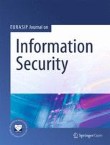Novel Attacks on Spread-Spectrum Fingerprinting
Spread-spectrum watermarking is generally considered to be robust against collusion attacks, and thereby suitable for digital fingerprinting. We have previously introduced the minority extreme attack (IWDW' 07...
